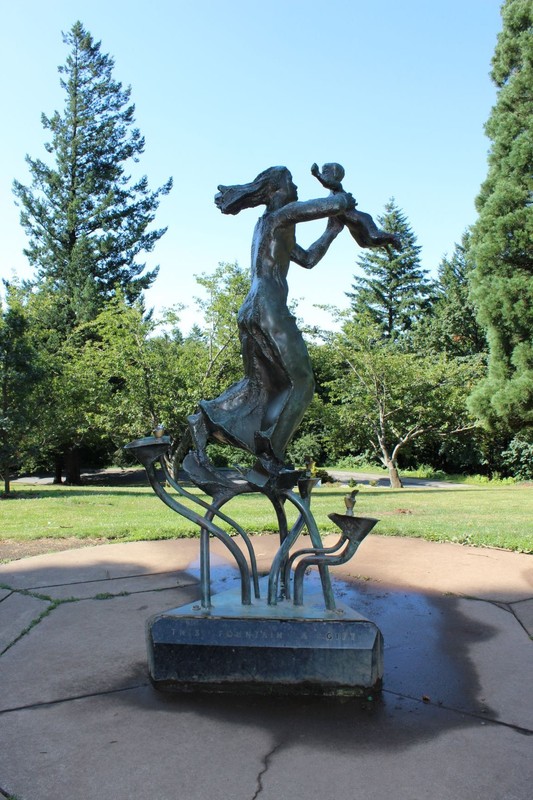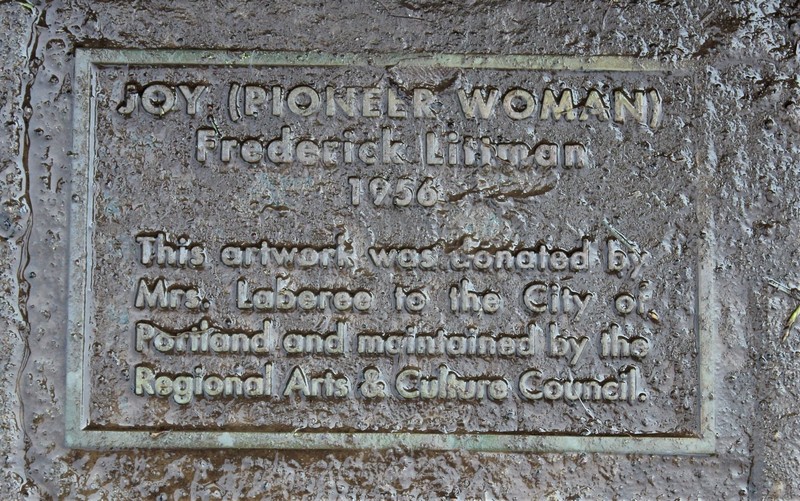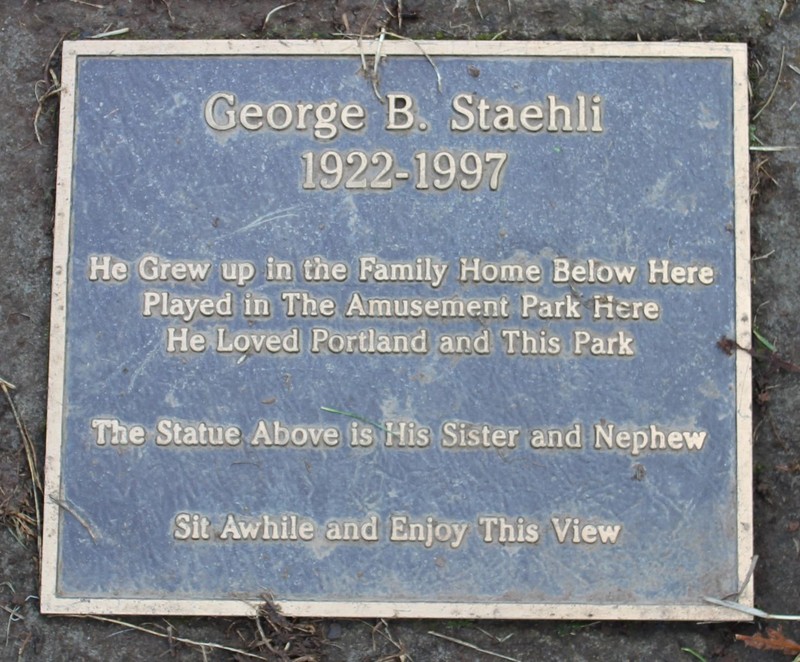Laberee Memorial Fountain
Introduction
Text-to-speech Audio
Also known as "Joy" or "Pioneer Woman," this statue and drinking fountain was sculpted by Frederic Littman in 1956. It is an adaptation of early-20th-century public fountains and Portland's iconic "Benson Bubblers."
Images
Joy (Pioneer Woman). Photo by Cynthia Prescott.

Joy (Pioneer Woman) plaque at base of fountain. Photo by Cynthia Prescott.

George B. Staehli plaque placed near fountain. Photo by Cynthia Prescott.

Backstory and Context
Text-to-speech Audio
Also known as "Joy" or "Pioneer Woman," this statue and drinking fountain was sculpted by Portland State College art professor Frederic Littman in 1956. The artist depicted a mother playing with her child in the park to symbolize joy. According to a plaque placed near the fountain, the mother and child depicted in the sculpture are the sister and nephew of George B. Staehli, who grew up near the park.
The artist intended to depict timeless joy in the mother-child relationship, rather than a particular era. Most artists shied away from sculpting traditional pioneer women in sunbonnets from the mid-1950s through the late 1960s, Fine art of that period was avant-garde and non-representational. But Western films and television shows were popular at that time. Older monuments depicting pioneer mothers stood throughout Portland and the Willamette Valley. And a number of other public fountains erected in the first half of the 20th century in the Midwest and West did feature pioneer women. It is therefore not surprising that Portlanders read the woman on the fountain as a pioneer woman. The plaque beneath the fountain identifies its title as "Joy (Pioneer Woman)."
The bronze mother and child stand above two drinking fountains. This fountain's design was a modern spin on public fountains donated by philanthropists to growing cities like Portland in the early 20th century. Elsewhere in the United States, Progressive Era fountains were typically carved from granite, and included a large round trough for work horses. Statues depicting pioneers were sometimes placed at the center of such fountains.
Portland has a unique history of public water fountains, though. By the 1920s, it featured dozens of iconic "Benson Bubblers," which were named for businessman and philanthropist Simon Benson. Benson donated $10,000 in 1912 to fund the installation of 20 bronze drinking fountains. Some say that Benson sought to reduce workers' consumption of alcoholic beverages during their lunch breaks. Others claim that he was inspired by the sight of a girl crying from thirst at an Independence Day parade. In the 1970s, the Benson family requested that traditional four-bowl bubblers only be installed within downtown Portland to maintain their uniqueness.
This fountain was donated by Florence and George P. Laberee. It stands on Council Crest, which is thought to be the highest point in Portland at 1,073 feet above sea level. The statue was stolen in the 1980s by vandals who sawed through the mother's ankles. The sculpture was recovered a decade later in Northeast Portland and reinstalled near the center of the park.
The artist intended to depict timeless joy in the mother-child relationship, rather than a particular era. Most artists shied away from sculpting traditional pioneer women in sunbonnets from the mid-1950s through the late 1960s, Fine art of that period was avant-garde and non-representational. But Western films and television shows were popular at that time. Older monuments depicting pioneer mothers stood throughout Portland and the Willamette Valley. And a number of other public fountains erected in the first half of the 20th century in the Midwest and West did feature pioneer women. It is therefore not surprising that Portlanders read the woman on the fountain as a pioneer woman. The plaque beneath the fountain identifies its title as "Joy (Pioneer Woman)."
The bronze mother and child stand above two drinking fountains. This fountain's design was a modern spin on public fountains donated by philanthropists to growing cities like Portland in the early 20th century. Elsewhere in the United States, Progressive Era fountains were typically carved from granite, and included a large round trough for work horses. Statues depicting pioneers were sometimes placed at the center of such fountains.
Portland has a unique history of public water fountains, though. By the 1920s, it featured dozens of iconic "Benson Bubblers," which were named for businessman and philanthropist Simon Benson. Benson donated $10,000 in 1912 to fund the installation of 20 bronze drinking fountains. Some say that Benson sought to reduce workers' consumption of alcoholic beverages during their lunch breaks. Others claim that he was inspired by the sight of a girl crying from thirst at an Independence Day parade. In the 1970s, the Benson family requested that traditional four-bowl bubblers only be installed within downtown Portland to maintain their uniqueness.
This fountain was donated by Florence and George P. Laberee. It stands on Council Crest, which is thought to be the highest point in Portland at 1,073 feet above sea level. The statue was stolen in the 1980s by vandals who sawed through the mother's ankles. The sculpture was recovered a decade later in Northeast Portland and reinstalled near the center of the park.
Sources
Pioneer Woman, (sculpture). Smithsonian Art Inventories Catalog. Accessed June 19, 2019. https://siris-artinventories.si.edu/ipac20/ipac.jsp?&profile=all&source=~!siartinventories&uri=full=3100001~!13625~!0#focus.
Benson Bubblers. Portland Water Bureau. Accessed June 19, 2019. https://www.portlandoregon.gov/water/article/352768.
Prescott, Cynthia Culver. Pioneer Mother Monuments: Constructing Cultural Memory. Norman, Oklahoma. University of Oklahoma, 2019.
Council Crest Park. Portland Parks and Recreation. Accessed June 19, 2019. https://www.portlandoregon.gov/parks/finder/index.cfm?action=ViewPark&PropertyID=24.
Benson Bubblers. Portland Water Bureau. Accessed June 19, 2019. https://www.portlandoregon.gov/water/article/352768.
Prescott, Cynthia Culver. Pioneer Mother Monuments: Constructing Cultural Memory. Norman, Oklahoma. University of Oklahoma, 2019.
Council Crest Park. Portland Parks and Recreation. Accessed June 19, 2019. https://www.portlandoregon.gov/parks/finder/index.cfm?action=ViewPark&PropertyID=24.
